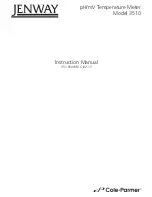
Input Waveform 0 to PEAK
Vrms
Average
Value
Crest
Factor
Form
Factor
Root Mean
Square Value
Vavg
Vp/Vrms Vrms/Vavg
Sinusoidal
wave
Square
wave
Chopping
wave
Pulse
=1.414
=1.111
Vp
Vp
Vp
1
0
0
p p
Vp
Vp
0
Vp
−
Vp
2
√
=0.707Vp
−
2Vp
=0.637Vp
2
√
Vp
−
2
√
2
π
Vp
Vp
1
−
Vp
3
√
=0.577Vp
−
Vp
2
=0.5Vp
−
2
3
√
=1.155
3
√
=1.732
τ
0
Vp
−
τ
・
Vp
−
τ
・
Vp
−
τ
−
τ
Vp
Check for the continuity.
― 22 ―
― 21 ―
4-15 Terms
Analog bar graph
The analog bar graph provides a visual indication of
measurement like a traditional analog meter needle.
True RMS
True RMS is a term which identifies a DMM that responds
accurately to the effective RMS value regardless of the
waveforms such as: square, sawtooth, triangle, pulse trains,
spikes, as well as distorted waveforms with the presence of
harmonics. This instrument employs the True-RMS (Root-Mean-
Square) detection.
Crest Factor
Crest Factor is the ratio of the Crest (instantaneous peak) value
divided by the True RMS value. Most common waveforms such
as sinusoidal wave and chopping wave have a relatively low
crest factor. A low duty cycle wave form like pulse string has
a high crest factor. For voltages and crest factors for typical
waveforms, see the table below. Please note that measurement
should be made under the crest factor below 3.
1. Do not use the instrument if the meter or test leads look
damaged.
2. Make sure the test leads and the fuse are not broken.
WARNING
Make sure the low battery indicator is off after power-on. Replace
the battery with new one if the indicator is on.
CAUTION
Perform pre-oparational check for safety.
(Inspection using continuity check)
[5] Measuring procedures
5-1 Pre-operational Check














































